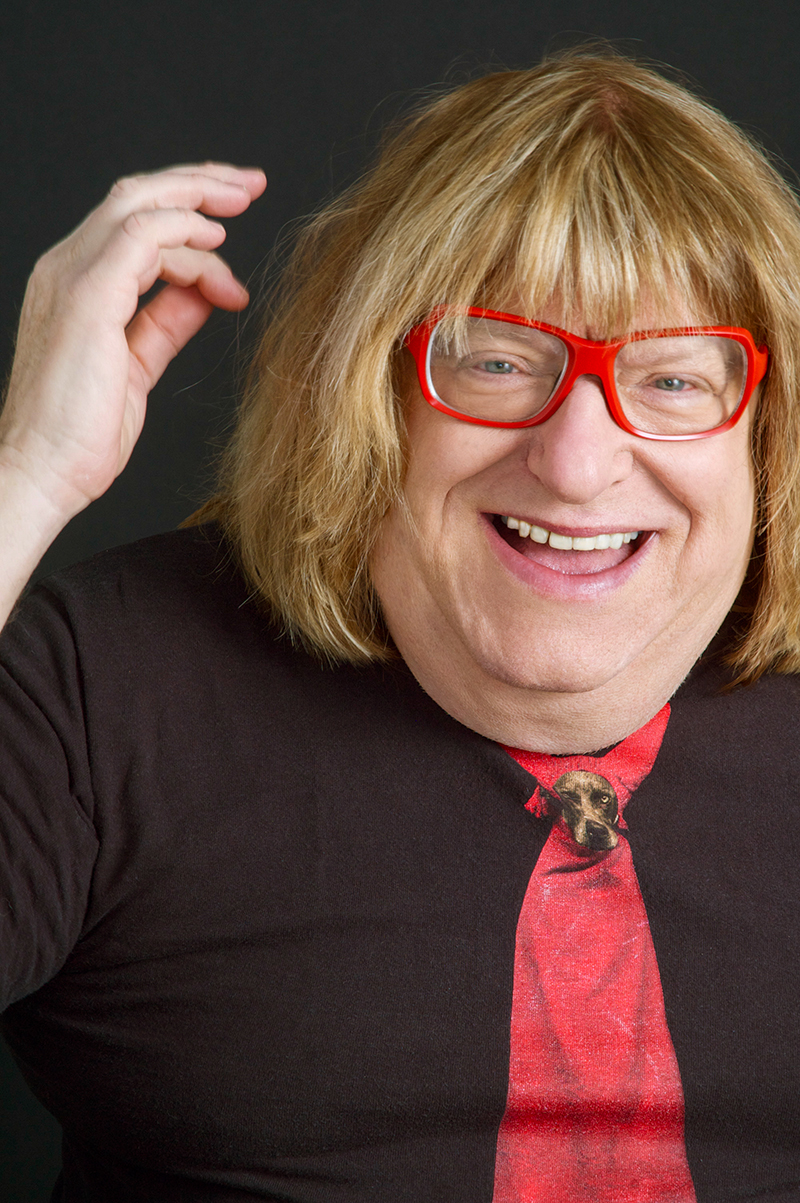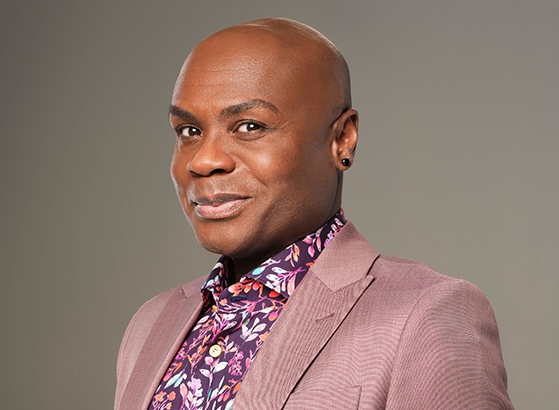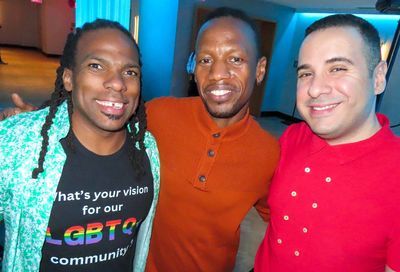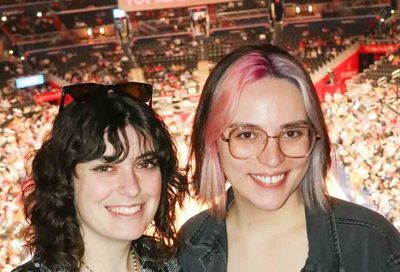Vern Yip on Trading Spaces, interior design, and why he loves D.C.
Vern Yip has built a career on making other people's living spaces better. At the Capital Home Show, he's ready to help you too.

When it comes to the humble candle, Vern Yip has a rather curious problem: “I don’t like to look at a burnt wick.”
Far from eccentricity, taking issue with a candle’s burned wick speaks to the way the 50-year-old architect and designer approaches all aspects of his work. “I make my way through the world by seeing things and thinking to myself, ‘That could be better. That could be designed better for no extra cost, or for less cost.'”
That’s why, when Yip was asked to develop a home fragrance collection, the wick problem became part of his inspiration for a set of candles.
“The candles, they all have lids on them, so that you don’t have to look at a burnt wick,” Yip says. “And the containers are proportioned to be useful after the candles are finished — they’re a perfect tumbler size, or the perfect size for Q-tips. We have some that are perfect candy dishes. The idea is that by giving something the right proportion, the right scale, you give it usefulness.”
That practical-minded, problem-solving approach has guided Yip throughout his career, which began its upward trajectory at the turn of the millennium through his role on TLC’s home decorating show Trading Spaces. Yip is one of a number of interior designers who oversee a redesign in a stranger’s house, working alongside the homeowner’s neighbors to make their renovation dreams a reality.
The enormous popularity of the show, which originally ran from 2000 to 2008 and was revived earlier this year on TLC, helped fuel changes in the design industry as well as in society at large. For one thing, in part because of the show and the spread of design-themed television in its wake, design is no longer thought of as literal window dressing, or a luxury that only the well-heeled can afford. Rather, it’s become more accessible, more affordable, and more valued in everyday life. And Yip couldn’t be happier that Trading Spaces has returned to provide more design inspiration.
“Trading Spaces launched my television career, and I’m obviously indebted to that opportunity,” he says. “It holds a special place for people. So it’s really exciting that it came back, and that we’re doing a second season of it.”
Prior to Trading Spaces, Yip had found success as an architect in Atlanta. He had no experience or even much interest in TV, and didn’t foresee it as a tool for design. Certainly he had no inkling that TV would become the springboard for his career and his various design pursuits — including books, fabrics, and lectures at events like the Capital Home Show this weekend at the Dulles Expo Center. And everything Yip does, regardless of medium, is focused on helping people solve problems in both form and function.
“Whether it’s a project — a home, a business — or a product, there always has to be a confluence of function and aesthetic,” he says. “Something can be beautiful, but if it doesn’t function correctly, to me it’s a failure. Similarly, if something just functions and it’s not aesthetically pleasing, it’s also a failure.”
A native of McLean, Va., Yip recently took time out of his busy schedule to discuss his life and career, and why he considers himself “the world’s luckiest guy” — a realization that hit after he turned 50 earlier this year.
“I get to work on the things that I really want to work on,” he says. “I get to pursue my passion and I get paid for it. I’m a family man, which I always wanted to be. And I have a great husband, I have great kids. Not only do I love my kids, I really like my kids. I feel incredibly lucky, truly grateful — grateful for everything I get to do.”

METRO WEEKLY: This weekend you return to the D.C. area for the Capital Home Show. What about that are you looking forward to?
VERN YIP: I’m really excited to be back in my hometown and to be talking to people about what’s happening in the world of design and how to inculcate design into their homes. It’s always special for me to be back in the D.C. area. It’s still my favorite part of the country, for a couple of reasons. Number one, I love that it’s such an international town. I grew up in the public school systems of Fairfax County, and had the opportunity to go to school with kids from all over the world, and I don’t think that happens almost anywhere else. It has a huge impact on you growing up. We send our kids to international school here in Atlanta for that reason, just the ability to be exposed to a broader variety of people.
And then I find people in D.C. incredibly interesting. It’s a very educated population, and a really informed population. People in D.C. love the news. It’s probably where I got my addiction to the news. Growing up, I remember, at the dinner table, we discussed what was happening in the world. We discussed politics — and back then you could have a differing opinion. You just had to be able to defend it.
MW: You left the area and put down roots in Atlanta, where you found early success as an architect. How did Trading Spaces come about?
VERN YIP: In the year 2000, I was named Southeast Designer of the Year [by Veranda magazine]. And it happened to coincide with when they were casting Trading Spaces. That award put my name and face in a bunch of magazines, and one of them landed on the desk of a production company that was in charge of putting together the first season, casting all of the designers and the carpenters. They asked me to come in and interview for the show. I have to admit I was reluctant initially. I was afraid that doing a show like this would torpedo my design career, because it had never been done. Back in 2000, there wasn’t this huge prevalence of shows that were design-focused. There weren’t a ton of shelter publications. It was a different world back then.
I eventually decided to seize the opportunity because it resonated with me — this concept that great design belongs in everybody’s home, that everybody should have the ability to benefit from great design in their lives. It’s easy to forget, but back in the early 2000s, it was mostly just the top rung on the socioeconomic ladder that could afford to have design in their homes. I thought, here’s an opportunity where we can really do a lot of good. I don’t think anybody anticipated that the show would take off the way that it did. It really resonated with folks. People really responded to it. And the rest is history.
MW: Has design become more accessible?
YIP: I think it has gotten significantly better. And I think a lot of it happened as a result of Trading Spaces and the launch of HGTV and of design programming. Also, I think people now realize the benefit of great design. Your home is the place where you spend the most important moments of your life with your friends and your family. People began to see real value in putting time and energy into the way their home looks, so that their home reflects who they are aesthetically and who they are functionally.
It also coincided with this movement away from having your home look like everyone else’s in your neighborhood, having to live up to somebody else’s standard, having to buy things in sets — the dining room set with the matching chairs and the matching china cabinet, or the living room set. It coincided with this time in history of embracing individuality, and the idea that having your own style is okay — not only okay, but preferable. And retailers responded accordingly. They responded to the popularity of Trading Spaces, the popularity of HGTV, and the increased demand they saw from people wanting more options that were well-designed and well thought-out, but also accessible.

MW: How has the show changed over its original version?
YIP: It’s a completely different world that we live in today. Doing Trading Spaces in the reboot version is really interesting because of that. When we initially did Trading Spaces, we didn’t have access to online shopping. We didn’t have things that could be delivered in 24 hours or 48 hours. We didn’t have all these sites offering such a wide array of things. Of course, that’s also daunting for the consumer. On the one hand, it’s wonderful that everybody has access to so much. But on the other hand, I think people sometimes get paralyzed by all the different options.
Another thing that makes it different is that people have a completely different point of view on design. Back when Trading Spaces first launched there was no Pinterest, there was no social media, there was no sharing of ideas like there is today. Certainly back then, we found that in straight married couples, the male oftentimes didn’t [express] an opinion. He often felt like he sort of had to say, “Happy wife, happy life. Whatever she wants.” In this rebooted version, everybody has an opinion, everybody feels like they have the ability to have a say, and I think that’s great.
MW: Does that make the process more contentious?
YIP: I think it’s made it more interesting and certainly more valuable. I always say the best design comes out of compromise. When one side gets their way and the other side just relents, it may look aesthetically pleasing, but it’s never going to last. And there’s always some sort of built-up resentment that will probably bubble-up down the road in some other form. So I love the idea that, no matter how disparate your partner’s point of view may be from yours, no matter how unappealing aesthetically you may think their point of view is, it’s worthy. And it should be taken into consideration.
MW: When did you become such a fan of design?
YIP: I have been a fan of design since the moment I came out of the womb. It was hard for me, being a kid of immigrants, especially Chinese immigrants, to think about pursuing a career in design, because Chinese culture really prizes the medical professions. I was always encouraged, like so many Asian-American kids, to grow up and become a doctor. My parents basically said, “You have two choices in life: You can grow up and become a doctor, or you can grow up and become a doctor. Completely up to you.” So I did my undergraduate at the University of Virginia, studying chemistry and economics — pre-med — and then applied to med school. I’d spent spring, summer, and winter breaks working at the National Institutes of Health in the transmitted and transfused viruses laboratory, working on asymptomatic HIV and hepatitis C.
Everyday I would go into work and I would think to myself, “Man, I’m so not interested. Why do we have to work with these horrible yellow walls? How come the lighting is so bad?” My mind was clearly not where it was supposed to be. Before medical school was about to start, I finally had the nerve to talk to my mom and say to her, “I can’t do this. I’ve known I’m supposed to design in one way or another my entire life.” And of course she knew that, too. She was so great about it. She said, “Well, then just go do it. You should have said something.” So I entered graduate architecture school at Georgia Tech. I got my masters in architecture and my MBA. I felt like I needed that MBA to give my mom the security that I was going to be okay. Because I think that was always her fear. It’s not that she didn’t want me to pursue something that had more of a creative bent, she was always fearful that I wouldn’t be able to support myself and support a family. And I understand that, now that I have kids myself. You want to leave this earth knowing that you’ve set your kid up to be okay, that they’re going to be fine.
MW: How was coming out for you?
YIP: Well, I think it’s daunting for everybody, no matter how completely open and accepting you think your family might be, because we still live in a world where being part of the LGBTQ community isn’t entirely accepted by everybody. But I was extremely fortunate to have a really supportive, loving mom, and a really loving, supportive older sister. My sister’s 10 years older than I am. My dad left when I was seven, so he wasn’t really in the picture. It ended up being fine. It was similar to working up the nerve to finally be able to say to her, “Hey I don’t want to be a doctor, I want to be an architect instead.” It was sort of the equivalent — though not nearly as bad. I was more fearful of disappointing her that she wasn’t going to have a doctor son, than she wasn’t going to have a straight son. She was lovely and great about it. I’m always so thankful because I know that that’s not everybody’s experience.
MW: What did you come out as first, a designer or as gay?
YIP: I told her architect because that’s what I wanted to be. I sort of fell into design. But yes, that preceded coming out as gay. So much of that was just having a difficult time really understanding where I fit in on the whole [LGBTQ] spectrum. It’s a different day and age that we live in today. If you rewind back 25, 30 years ago, there were very few portrayals of gay people in the media. And the portrayals that were out there fell into a very specific stereotype that I didn’t personally identify with. And that made it very confusing.
Of course once I came out, I realized that the spectrum of gay people is just as broad as the spectrum of straight people. But I didn’t know that until I was in the community. After meeting other gay men, I came to realize it’s different for everybody — there are some people who know really early on, and there are other people like me who take a second to figure it out.

MW: Were you out during the original run of Trading Spaces?
YIP: No, I wasn’t. I was still struggling to figure it out. In fact, my husband is the only man that I have ever been with, which I know is unusual. But it just happened to work out that way.
MW: I’ve met gay people who have little to no design sensibility. Yet, as an avid viewer of the original Trading Spaces, there was something about your discerning approach and overall tasteful style and aesthetic that just really appealed — and also read as gay. Did anyone ever make that connection?
YIP: Actually, I have never heard that before. My design point of view has always been informed primarily by two things. Number one, going to school, and having that architectural background and training. I’ve become kind of famous on the show for doing diagrams, which I do down to the 32nd of an inch. I like preciseness, and I like the cleaner line. That’s informed by the architectural training, but also, number two, by my cultural heritage. We moved to the States when I was two months old, but I was raised in a very traditional Chinese household, and always around lots of beautiful things — primarily from China, but from other parts of Asia as well. And my mom always had a great design sensibility. The Chinese aesthetic tends to be a little cleaner-lined.
MW: There is something about your style and amiable way that is widely appealing and seemingly hard to argue with. Have you ever had a homeowner on the show be unhappy with your work?
YIP: You know, I have been super fortunate. If they weren’t happy, I really didn’t hear about it. I kind of try to put my personal point of view to the side and give the homeowners the best possible version of what it is that I think they want. Because at the end of the day, I don’t have to live there. It’s not my home. It’s probably the biggest investment they’ve made in their lifetime, buying a home. So I want to be super respectful of that. And it’s really important to be invested in them and what they want. I get a big kick out of pleasing people — I have my entire life. It’s just part of my makeup. And so I try very, very hard to figure out who they are, what they’re about, and how I can help them in the best possible way. That’s always been something that is the primary driver behind my designs.
It’s sometimes difficult for me to figure out why I do [certain] things. Is it just the way I was born? Is it because I was raised in an Asian household? Is it because I’m gay? I mean, people are so complex, and we’re made up of so many different components, and influenced by so many different areas. It can be difficult to figure out, but it is definitely something that has been part of me since the beginning.
MW: Is it true that a lot of your initial passion for architecture and design was nurtured in the museums of D.C.?
YIP: I grew up in McLean, and spent a lot of time at museums. I’ve always loved museums and became super-influenced by their design. And I am a huge I.M. Pei fan. In fact, he is the reason why I ended up going to Georgia Tech for graduate school. When I told my mother that I [wanted] to go to architecture school, she put me on a train — we both went up to New York [to see Pei]. He’s a family friend. We walked into his office and he said, “You should go to Georgia Tech, that’s where all my best interns are coming from.”
I grew up marveling at museums — specifically the East Building of the National Gallery of Art, which [Pei] designed. I remember being in that space and thinking, it’s amazing that a physical space can have so much power to impact somebody’s experience and bring people together. And it is still to this day one of my absolute favorite spaces. So that really kind of planted the seed in me early on — if I didn’t have to be a doctor, this is what I would do. I want to design buildings. I want to be an architect.
MW: Let’s talk about your home life. How old are your kids?
YIP: Our son Gavin is eight, and our daughter Vera is seven. And they’re both so much fun. They love to do all the things that we love to do, so it’s been a really joyful experience. It’s not like every day is easy — it’s a lot of work. It’s an incredible amount of work to be a parent. But at the same time, it’s the best thing that I’ve ever been involved in. Hands down. It sounds so cliché to say, but it’s the truth for me. I don’t think everybody’s meant to be a parent, and I don’t think everybody who is a parent loves it. I feel incredibly fortunate for what I’m experiencing.
We love to travel, and we’ve taken the kids all over — they’ve been to Asia three times, they’ve been to Paris, they’ve been to London, they’ve been to all different parts of Italy. We’re going to Australia with them later this year. So they love to travel, they love adventure. They’re foodies like we are — they are really adventurous eaters. It’s what I mean when I say, not only do we love them, we actually like them. They’re fun to hang out with.

MW: And you’ve still got years to go before they become teenagers. It might be a different story then.
YIP: It very well could be, but we’ve had all kinds of warnings from people: Wait until they’re two, the terrible twos, wait until they’re five. We never had terrible twos. They were never difficult or horrible to deal with. They haven’t had a bad age. And I feel so incredibly grateful to be able to say that. But who knows? It might all catch up with me, like you say, when they’re teenagers, but I somehow don’t think so.
MW: Do they take after you with an eye for design?
YIP: Yeah, they have really good design eyes. I remember before they were born, a couple of friends came over and said, “Look at your house, all this stuff that’s on the coffee table, its got to go. Everything that’s breakable that they can reach, its got to go.” But I wasn’t raised that way. I was raised in a really beautiful household that was appointed with a lot of valuable, breakable things. And I was expected to understand what should just be looked at, versus what could be touched gently, versus what was no big deal to handle. I broke a few things for sure, but at the end of the day, it exposed me to these things. I lived with them and I became very visually sensitive as a result. So we decided to take the same approach with our kids. And I don’t know if that’s why they’re design-oriented, or if it’s for another reason. But yeah, they have really good design sense.
MW: I understand you also have four big dogs. I imagine you have to keep some things out of their way.
YIP: Yeah, we live with over 500 pounds of dog. We don’t let them go upstairs, but that’s not because of things that are breakable. They have full ability to roam downstairs, and they’re around tons of breakable things. And it’s sort of like with the kids — our kids have broken a few things, and the dogs have broken a few things. But at the end of the day, I view it as, those are just things. I would much rather have the experience of being in a home that I really appreciate and that I love the look of, and allow my family to enjoy the same.
MW: Is your mother still with you?
YIP: No. She passed away about 12 years ago. I am saddened that she never got to meet our kids, because I’m convinced that she would absolutely adore them. But you know, I still feel her presence. She was such a strong influence on me. She was my best friend until she passed. I find myself parenting in a very similar way to the way that she did.
MW: Did she meet Craig, your husband?
YIP: She did, and I feel really lucky about that. She had a long battle with cancer at the end of her life. I remember one specific day she mustered up enough energy to take [Craig] for a walk around the neighborhood. Which was a big deal for her, because she was kind of bedridden at that point. And she gave him a stern warning: “You better take care of him.” So she knew that he was going to be the one, and I love that.
MW: I understand that Craig works with you to some extent. Is he also a designer?
YIP: He is not, though he has a great design eye. I don’t ask for many people’s design opinion, but his is one that I will ask for, and that I have great respect for. If he wanted to be, he could be an amazing designer. But he was one of the very first people in the country to start dog daycare boarding and grooming. He has a company called Wag-A-Lot with several stores in the Atlanta area. And then he’s also in charge of a lot of my career — from licensing for products to show appearances and the like.

MW: You originally moved to Georgia for grad school. Did you end up staying because you fell in love with Atlanta?
YIP: No. I ended up staying because I graduated from architecture and business school at the bottom of the recession when very few people were landing jobs. In fact, I was one of the very few people in my graduate architecture school to land a job. And I landed it because I had two masters degrees. It was for the largest firm in the southeast, Thompson, Ventulett, Stainback, and Associates, TVS&A. I was hired as an architecture intern. I guess they sort of felt like if work got too slow because of the recession, they could always use me for business purposes.
It was a really good job, especially considering how difficult it was at that time economically, so I ended up staying. It’s not that I didn’t fall in love with the South. I had sort of envisioned that I would move to New York or LA, or San Francisco or Chicago — somewhere where things seemed to be happening more rapidly from an architectural standpoint, from a design standpoint. But the opportunity was here, and I’m really glad I stayed. I think it’s an incredible place to live. It’s a wonderful place to raise a family. I travel a tremendous amount for work, and having access to the world’s busiest airport is a huge plus. I can fly pretty much anywhere direct. And I wouldn’t have met my husband if I hadn’t been based here. So it all worked out.
MW: Do you watch much TV on your own, or have any thoughts about TV beyond your own work?
YIP: I watch a variety of things. I love watching people at their creative best, so I’m still a huge fan of Project Runway, I’m still a huge fan of Top Chef. I love those kinds of shows where people are given the opportunity to demonstrate their creative thought under duress. But I also watch a bunch of other stuff on Netflix. And I’m a newshound — a byproduct, I think, of growing up in the D.C. area. I read a physical newspaper in addition to watching the news online — and I still watch all three national news broadcasts. I’m probably showing my age, but I get something out of it.
When young designers ask me for advice, I tell them to travel as much you can. It’s really important to travel and see the world, not just images via the internet, but to be there, to touch it, to smell it, to meet the people, to eat the food. You have to be immersed in it. And the second thing I tell them is, get as educated as you can and be as informed as you can. Stay on top of what’s happening in the world. Stay on top of the news. I just feel like it’s critical for being a good designer. It’s not like there’s a direct translation — I see something on the news and it somehow inspires me to design. I don’t think it works that way, but the mind is a complex thing. And I think it’s part of being a designer, understanding the world and being tuned in.
MW: What’s in store for your future?
YIP: I’m incredibly grateful for the life that I live, and the opportunities that I’ve been given. I really look at my future and I think I would just love to keep doing the same things that I’ve been doing, and doing more of it. But no matter what I do or accomplish professionally, I can truly say my most favorite thing is being a dad and being a husband. For me it’s unquestionably the most special, meaningful aspect of my life. And to be able to say that as a gay man is incredible, because that was one of my major stumbling blocks [to coming out]. I always knew I wanted to be a dad, and for that to be a huge part of my life. And I didn’t really see that in the gay community.
I’m incredibly thankful to be able to be a gay man in this day and age where I have the right to be married. I have the right to raise a family. Is it perfect where we are in this country with gay rights? No. It’s not perfect. But have we made huge advances? Yes. I think we have, because a lot of people have sacrificed a lot to make that happen, and I’m super-grateful for those people doing what they’ve done to allow me to live the life that I’m living.
The Capital Home Show is Friday, Sept. 21, and Saturday, Sept. 22, from 10 a.m. to 9 p.m., and Sunday, Sept. 23, from 10 a.m. to 6 p.m., at the Dulles Expo Center, 4320 Chantilly Shopping Center, in Virginia. Vern Yip will appear on Friday, Sept. 21, at 4 p.m., and again on Saturday, Sept. 22, at noon and 2 p.m. Tickets are $10 per day. Call 703-378-0910 or visit capitalhomeshow.com.
Support Metro Weekly’s Journalism
These are challenging times for news organizations. And yet it’s crucial we stay active and provide vital resources and information to both our local readers and the world. So won’t you please take a moment and consider supporting Metro Weekly with a membership? For as little as $5 a month, you can help ensure Metro Weekly magazine and MetroWeekly.com remain free, viable resources as we provide the best, most diverse, culturally-resonant LGBTQ coverage in both the D.C. region and around the world. Memberships come with exclusive perks and discounts, your own personal digital delivery of each week’s magazine (and an archive), access to our Member's Lounge when it launches this fall, and exclusive members-only items like Metro Weekly Membership Mugs and Tote Bags! Check out all our membership levels here and please join us today!
























You must be logged in to post a comment.